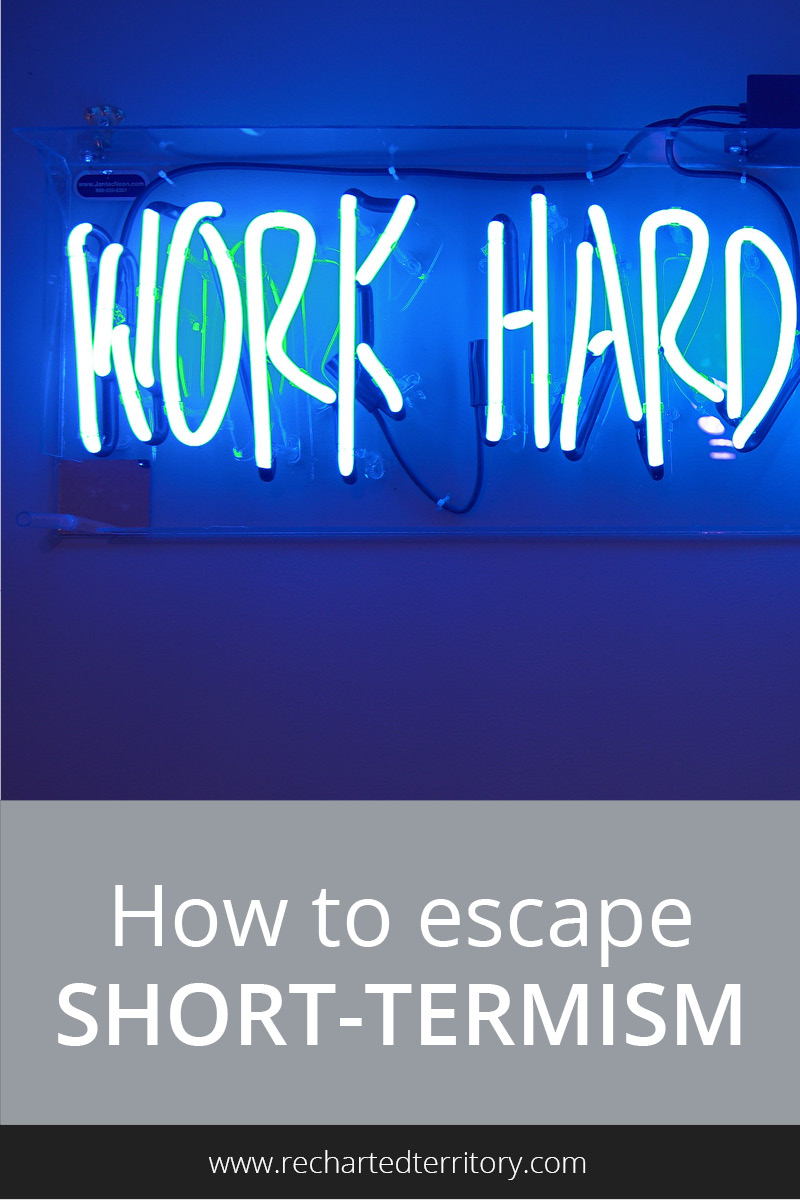

Living with short-termism means always looking just a few days or weeks ahead. It means having minimal margin in your schedule to do anything beyond implementing your to-do list, talking about your tasks, and reporting on your progress. It means hands on keyboards at all times (when not in status meetings).
Finding the right balance between strategic and tactical thinking seems to be a challenge. Teams can end up swinging too far to the strategic or tactical side.
They might push off strategic work in favor of the tactical, ending up only looking at small, easy items that may or may not relate to the long-term vision. Once they run out of “quick wins” they need to stop delivering and go through extensive discovery and analysis exercises to figure out what to build next.
Alternatively, they err on the strategic side, constantly analyzing and dreaming until there are stacks of interview notes, graphs, ideas, and project plans but little time or resources left to execute on the concepts that have already been selected.
Most people who end up in tactical mode aren’t against strategic planning and would actually prefer to spend more time doing it. It’s motivating and exciting to think about the broader purpose and imagine what they could create. Their biggest concern with strategic planning is that they see it as time-consuming compared to the relative value it adds.
“We can’t take a few days to do strategic planning because there are phones to answer and current operations to run. Between keeping the lights on and upgrading the bulbs (aka incremental improvements), we’re running out of time in the day.”
This mentality scales up to companies. Some companies struggle with balancing what consulting firm McKinsey calls the 3 horizons of growth. They tend to focus on current operations first, followed by incremental improvements, and then longer-term exploration or business model changes are the first to go when resources get tight.
But that’s not how market leaders add exponential value. They work on all three horizons concurrently.
One way companies try balancing longer-term visioning with shorter-term operations is by breaking out a “strategic” group who will do all of the strategy work. Another is by building in breaks during the year for research and planning. Or to wait until people have run out of things to work on before kicking off a strategic planning process.
There’s another option.
Create strategic routines.
Rather than delegating strategic thinking to certain people or times of the year, everyone can add strategic time to their own work. The key is to build in habits and routines in your regular schedule so that you’re constantly scanning the landscape and coming up with new ideas, while also executing and studying the impact of work that you previously decided to tackle.
Balance strategy and tactics with strategic routines.
By baking in strategic habits that both serve the organization’s current needs while creating progress on longer-term initiatives, companies will be able to grow existing business models and take immediate steps toward opportunities to create more value and explore new markets.
Like working out and eating healthy, while a retreat to learn some new techniques and create a plan can be a helpful kick-start, consistent action is required for lasting impact. With the pace of change, you can’t create a strategic plan once and be done with it. Picking your head up often helps to ensure that you’re on track and that decisions you’re making each day are leading to the larger vision.
Examples of actions to take and habits to build throughout the year:
Yearly
- Host an off-site retreat for thinking really big.
- Set or update vision for the next 3, 5, 10 years.
- Review and update guiding principles.
- Examine your entire business, including analytics.
- Research industry and market trends and explore multiple directions (what if?).
- Explore new partnerships and funding streams.
- Review the trajectory of similar companies a few years ahead of you for patterns you can follow (or intentionally deviate from).
- Review your current products, services, and processes and consider which ones to continue or scale back.
- Design alternative business models and pick a few to explore further during the next year.
- Learn new concepts completely unrelated to your current path (ex. from other industries or roles).
Note: You can reference and update this plan during the year but dedicating some time annually to really dig in and design it is probably enough given the timescale. If you change it too often then you might not have time to make significant progress on the larger projects and milestones that are needed to achieve your longer-term goals. The key is to have a clear vision of what you want in the long-term while keeping the details about how you get there flexible.
Quarterly
- Review business metrics and customer feedback. Complete root cause analysis for problematic areas.
- Set targets for the next few quarters and select a few big projects. The near-term projects will earn most of your attention. Keep the longer-term projects in mind and to set aside time now for tasks related to relationship building, learning, or architecture planning that will pay off later on.
- Define leading and lagging indicators for your current business model and the large projects in your pipeline.
- Break down projects for the next quarter for easier monthly and weekly planning. Include questions to answer, experiments to run, plus research and interviews needed for the business areas and customers impacted by those projects.
- Adjust budgets as needed, especially if upcoming projects or revenue spikes caused a need for change.
- Celebrate goals achieved in the last quarter.
Monthly
- Review past actions and plan activities for the next month (ex. block out time for running Enterprise Design Sprints). The key is to factor in building, monitoring, learning, and planning time. Many teams only factor in building time.
- Review internal and external feedback related to projects in-flight.
- Read articles related to the customers, business processes, or technology that you’re focusing on this month.
Weekly
- Review how you’re investing your time and money and make updates as needed.
- Batch work if possible. Set aside some strategic time each week, leaving the rest of the time for shorter-term priorities. Use your strategic time to work on planning, research, or projects that might not be implemented until 1-3+ months in the future. Try either a 2-3 hour block each week or the 30/30 technique, where you spend 30 minutes each day working on something that won’t be delivered until at least 30 days later.
As needed
- Capture any information, such as ideas, insights, or references that you find in your daily work or learning breaks.
- Add notes related to current or future projects.
- Track and review outcomes of research into customer trends, industry, and technology options.
- Review the vision and mission for inspiration and to check that you’re on track.
Exactly which activities you take on when can vary, but the key is to shift from large strategic projects to regular routines. That allows strategy to stay top of mind and for insights to more rapidly impact executing teams.
However, getting there can require overcoming resistance while you build the habits. In “The Power of Habit,” Charles Duhigg suggests paying attention to the cues that trigger a new routine, and the reward that you receive at the end to help a new habit stick.
How to protect strategic time
- Set cues. Schedule a weekly recurring meeting, with no end date. Set aside time for both individual analysis and synthesis as well as discussions with others about your findings and ideas.
- Build a team. Making this a team meeting adds external accountability. We’re less likely to blow off a commitment to others than one to ourselves. If team dynamics are good, it can also add an extra socialization reward and make people more excited to attend.
- Address issues early. Call out people right away if they don’t attend the regular strategy meeting. Find out what prevented them from attending.
- Keep the sessions effective. Make all meetings relevant, productive, and only as long as they need to be. The sense of progress and tangible outcomes provides a “reward” to help the habit stick. Check out this post for tips on designing meetings.
- You don’t need to stay at the 10,000-foot level. Cycle through shorter-term and longer-term topics, based on where the current bottleneck is for making decisions.
- Vary the format to keep people engaged. Try presentations, workshops, different facilitators, or different venues.
- Be flexible (within reason). If everything truly is on fire then it’s ok to cancel the meeting one week. But don’t go beyond that or the strategic meetings will be seen as optional.
- Don’t let it turn into a passive status meeting. People should be learning, creating, or adjusting the plan. Status updates can happen in other tools or forums.
- Make it easy to start the next meeting. Plan out agenda topics the meeting or month before. If people aren’t sure what will be accomplished in the meeting, who’s facilitating, or what to prepare, it’s easier to punt it in favor of more concrete work.
- Engage everyone. Add accountability without a lot of extra work by having each team member lead one meeting per month.
Strategic thinking doesn’t need to be restricted to a small group, a powerpoint deck, or a certain time of year. By building in these practices and habits, you can create, reference, and refine your strategy as you go, improving your tactical delivery at the same time.
How does your organization handle strategic thinking? Who tackles it? When?